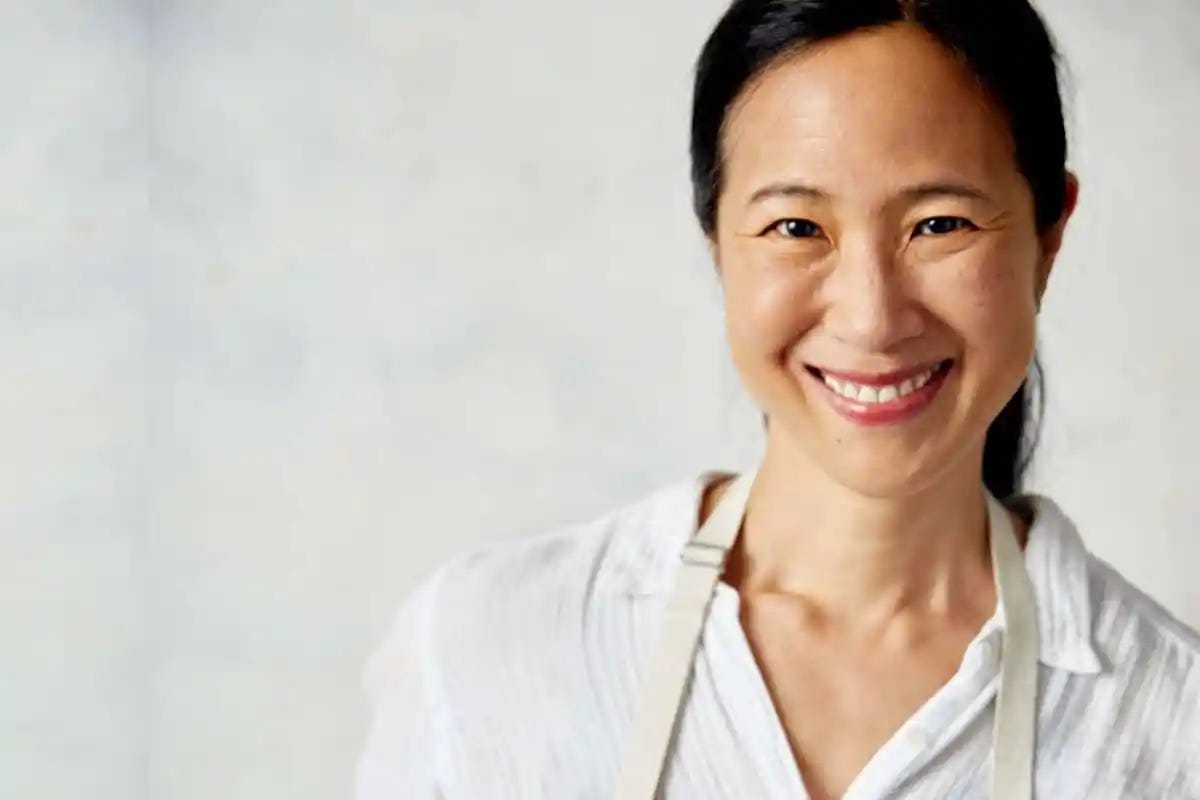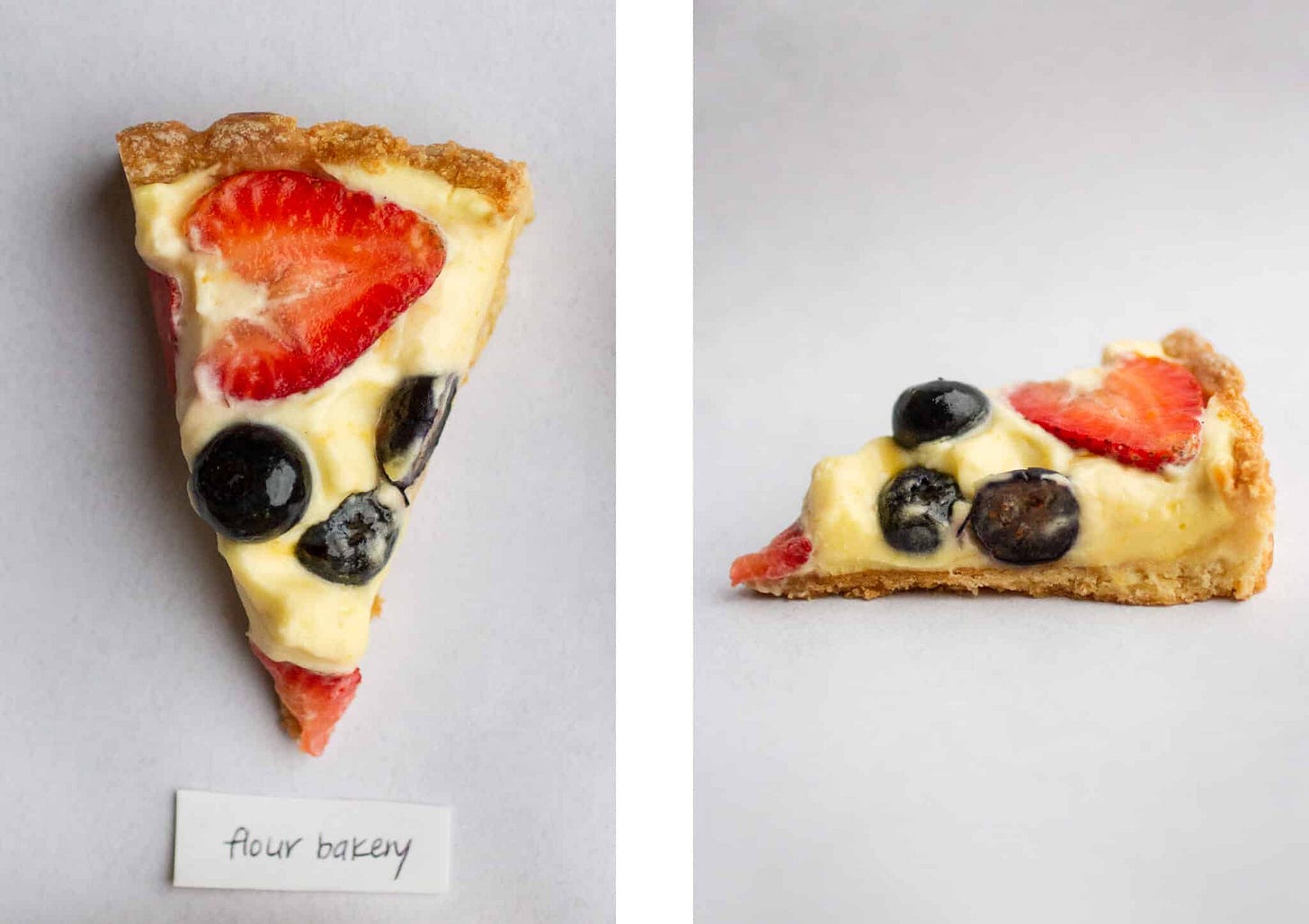Hello and welcome to our fruit tart newsletter! In this newsletter, we have:
An interview with pastry wizard Joanne Chang: diving into crusts, pastry creams and all things fruit tart!
How I selected the recipes for this bake off: plus a link to the master spreadsheet in case you want to investigate or compare recipes
Summer baking inspo! Featuring specific picks from past bake offs
The fruit tart bake off is yet another bake off I wasn’t sure would ever happen—the complications of juggling pastry + pastry cream + fruit seemed too complex to make 9 in one day. Ultimately, after pulling it off, I have a few thoughts:
Strive for thin crusts! Although my urge was to roll the crusts thicker to use up all the dough, the thinner crusts tend to be more flaky and delicious. (They also tend to cook through faster and more evenly). It’s also so easy to bake off extra dough scraps on a cookie sheet with a sprinkling of sugar—they’ll disappear quickly, promise!
Rolling is king: Most fruit tart crusts direct you to roll out the dough (vs. pressing it into the pan) for good reason—I found this was the easiest way to keep the crust thickness consistent. Note that if the crust cracks, it’s better to patch it with extra dough scraps rather than re-rolling the dough (which can cause gluten development and shrinkage). Pressing the crust into the pan a la Alison Roman definitely works and yields a beautiful rustic look, so it just depends on your aesthetic goals. I struggled with Claire’s technique (cutting strips of dough to line the sides of the tart pan and pressing the remaining dough into the bottom) because it was difficult to seal the sides and bottom together.
Stagger the work for breezy results: Fruit tarts are actually one of the easiest, most show-stopping desserts to make if staggered over a couple days. I recommend making the pastry cream and dough the day before. The day of, all you’ll need to do is bake the crust and assemble everything. Everyone will be impressed!
I always list my personal bake off picks at the bottom of each blog post but here’s a bit more color:
The fruit tart I’d reach for when I’m crunched for time and in the mood for something easy: Alison Roman
My ultimate combination: I’d use the crust from Flour Bakery or King Arthur (they’re almost identical; KA uses a little more flour and milk) with the pastry cream from Alison Roman.
AN INTERVIEW WITH JOANNE CHANG OF FLOUR BAKERY
In case you missed it, tasters voted Flour Bakery’s fruit tart as the crowd-winning pick. I’m thrilled to include an interview with Joanne Chang, owner of Flour Bakery and a James Beard Award winner for Outstanding Baker. I’ve long been an admirer of Joanne and her fabulous cookbooks (her recipes have won several bake offs) and hope to one day make it to her bakery in Boston.
Your crusts are consistently amazing--your pumpkin and apple pies topped the charts of my previous pie bake offs and your tart dough is just as fabulous. Is the pate sucree a recipe you picked up at Payard or one you developed organically?
The pate sucree originally comes from Payard—it was a workhorse that we used for so many things! It's been over 25 years so it has evolved as we have scaled up and down and changed out brands of ingredients, but at the core it is from Francois Payard. The pate brisee recipe that is used for our pumpkin and apple pie actually come from the very first pastry chef I worked for, Rick Katz. He taught me how to fraisage, or smear, the dough so that it is super flaky and tender. A key to success with both dough recipes is to bake them thoroughly. I often find that doughs are underbaked and they end up being doughy and tough.
Your signature seems to be using egg yolks in most tart/pie doughs--presumably for flavor/tenderness, but can you comment on why?
Egg yolks are flavored fat and fat adds flavor so they are a double whammy of flavor. They are an emulsifier and add tenderness to the dough as well.
Any tips for rolling out dough with minimal cracking? Should tart dough be rolled out cold from the fridge?
To prevent cracking the dough cannot be straight from fridge—the butter at that point is too firm and it results in cracks. So temper the dough at room temp for 10 or 15 minutes. When you roll, first press the dough flat and then gently roll out.
Why do you prefer a diplomat over a creme patissiere for fruit tarts? (Or: when would you use one over the other?)
Pastry cream is too thick and cloying for me for a fruit tart—I much prefer to lighten it with whipped cream to allow for a softer mouth feel and to let the fruit shine.
You mention that when creating fruit tarts at Flour, you wanted just the fruit, no nappage. Is this for flavor purposes?
When you have ripe seasonal fruit you don't need nappage to give it flavor or keep it fresh. Using nappage in a bakery means the fruit will last a few days longer than if you did not use nappage—and to me that means the fruit tart is not as fresh. So we avoid it to keep us from selling "old" fruit.
Would you recommend using apricot preserves or any different kind of glaze for home cooks? Or is plain best in your opinion?
I like apricot preserves for home use—it adds not only a touch of sweetness but also acidity. Thin it out so it is not gloppy!
If you could only eat 3 desserts for the rest of your life, what would they be?
Oh my! Yogurt gelato from Grom, mango shaved ice from a little shop in Kaohsiang Taiwan, fresh baked red bean and custard wheel cake from a cart in Taipei.
Thank you so much, Joanne! If you’d like to learn more about Joanne and her fascinating pastry career (she switched from management consulting into the pastry world!), give this podcast episode a listen. And make sure to visit Flour Bakery if you’re in Boston!
HOW I PICKED THE FRUIT TART RECIPES
Selecting recipes was tricky as it required a balance of looking at differences in the pastry cream and the crust. Ultimately, I focused more on differences in the pastry cream (which did mean some of the crusts were quite similar). Factors included: whole eggs vs. egg yolks, cornstarch vs. flour, the ratio of sugar and butter, etc. Here’s why I chose each of the recipes:
King Arthur: whole egg pastry cream + thickened with a combination of flour/cornstarch
Tartine: Essentially the same as King Arthur but with added whipped cream to make it a diplomat + a whole egg pastry crust
Flour Bakery: A diplomat cream like Tartine but with all egg yolks instead of whole eggs
Ricardo Cuisine: Uses a combination of lower-fat milk and cream (vs. all whole milk), a combination of whole egg and yolks, and thickens the cream with flour and cornstarch
Claire Saffitz: Nearly identical to Dorie Greenspan, but uses a unique almond crust
Dominique Ansel: High ratio of egg yolks (9!!)
Alison Roman: Uses a no-egg, melted butter crust that gets pressed in with a pretty standard pastry cream that has a high salt ratio
Culinary Hill: relatively high ratio of egg yolks and a slightly lower ratio of butter in the pastry cream with a whole egg crust
Salad in a Jar: Microwave technique for the pastry cream
This master spreadsheet contains most of my bake off spreadsheets where I collect and compare recipes. If you ever want to compare your favorite recipes against the ones I’ve tested, this will make it easy!
MORE FUN SUMMER BAKES
Best Tres Leches Bake Off: Tres leches is such a cooling dessert—this feels like a perfect summer dessert adorned with some fresh bereries! Ina Garten is my pick.
Best Sweet Cornbread Bake Off: Looking for a sweet cornbread recipe to take to a cookout? The winner of this bake off (Mel’s Kitchen Cafe) is basically corn cake disguised as cornbread and is DELICIOUS.
Best Zucchini Bread Bake Off: Are we in zucchini season yet? Dropping this here for when you need it! Smitten Kitchen was the crowd fav, though I also love Not Without Salt for something fun and different.
My favorite pancake recipe: I’ve had some requests for my favorite pancake recipe lately. I love this VERY thick and fluffy recipe, though I also love the Chez Ma Tante recipe on NYT for a very decadent option. My pancake “bake off” can also be found here.






I loved reading this interview!